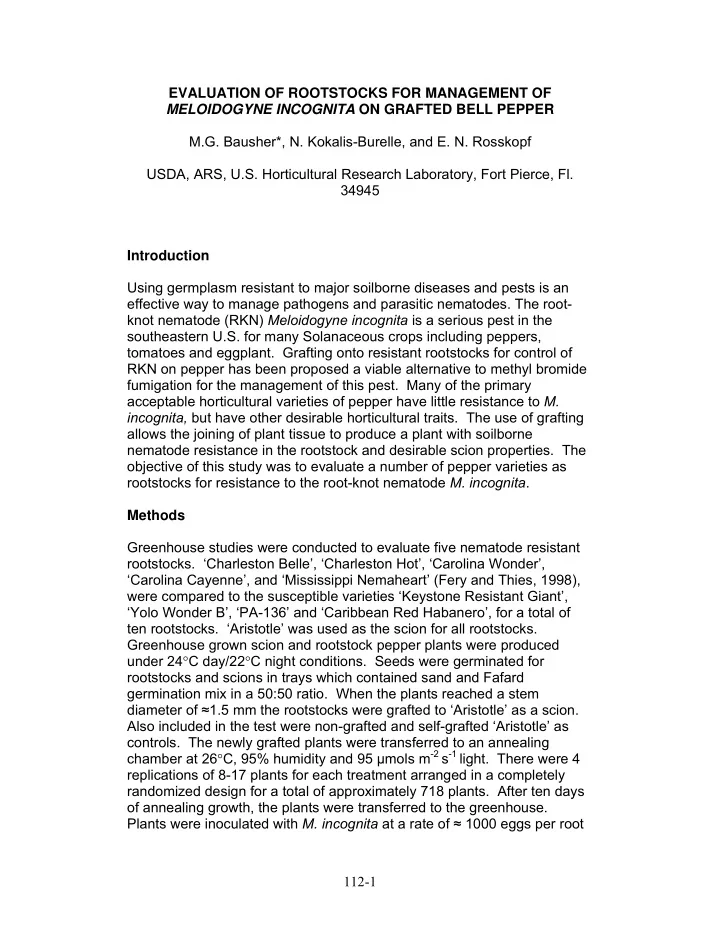

EVALUATION OF ROOTSTOCKS FOR MANAGEMENT OF MELOIDOGYNE INCOGNITA ON GRAFTED BELL PEPPER M.G. Bausher*, N. Kokalis-Burelle, and E. N. Rosskopf USDA, ARS, U.S. Horticultural Research Laboratory, Fort Pierce, Fl. 34945 Introduction Using germplasm resistant to major soilborne diseases and pests is an effective way to manage pathogens and parasitic nematodes. The root- knot nematode (RKN) Meloidogyne incognita is a serious pest in the southeastern U.S. for many Solanaceous crops including peppers, tomatoes and eggplant. Grafting onto resistant rootstocks for control of RKN on pepper has been proposed a viable alternative to methyl bromide fumigation for the management of this pest. Many of the primary acceptable horticultural varieties of pepper have little resistance to M. incognita, but have other desirable horticultural traits. The use of grafting allows the joining of plant tissue to produce a plant with soilborne nematode resistance in the rootstock and desirable scion properties. The objective of this study was to evaluate a number of pepper varieties as rootstocks for resistance to the root-knot nematode M. incognita . Methods Greenhouse studies were conducted to evaluate five nematode resistant rootstocks. ‘Charleston Belle’, ‘Charleston Hot’, ‘Carolina Wonder’, ‘Carolina Cayenne’, and ‘Mississippi Nemaheart’ (Fery and Thies, 1998), were compared to the susceptible varieties ‘Keystone Resistant Giant’, ‘Yolo Wonder B’, ‘PA-136’ and ‘Caribbean Red Habanero’, for a total of ten rootstocks. ‘Aristotle’ was used as the scion for all rootstocks. Greenhouse grown scion and rootstock pepper plants were produced under 24 ° C day/22 ° C night conditions. Seeds were germinated for rootstocks and scions in trays which contained sand and Fafard germination mix in a 50:50 ratio. When the plants reached a stem diameter of ≈ 1.5 mm the rootstocks were grafted to ‘Aristotle’ as a scion. Also included in the test were non-grafted and self-grafted ‘Aristotle’ as controls. The newly grafted plants were transferred to an annealing chamber at 26 ° C, 95% humidity and 95 μ mols m -2 s -1 light. There were 4 replications of 8-17 plants for each treatment arranged in a completely randomized design for a total of approximately 718 plants. After ten days of annealing growth, the plants were transferred to the greenhouse. Plants were inoculated with M. incognita at a rate of ≈ 1000 eggs per root 112-1
system. Total soil volume for these tests was 20.5 ml. Plants were hand watered and allowed to grow for 67 days, after which plant growth and disease data were collected. Data were analyzed for analysis of variance using the general linear models procedure (GLM) and mean separation was performed using the least significant difference procedure (LSD) (SAS version 9.1, Carey, NC). Differences are reported at P ≤ 0.05. Results Root galling was highest on ’Yolo Wonder’ and lowest on ‘Charleston Hot’ rootstocks (Table1.) The gall ratings from lowest to highest were: ‘Charleston Hot’<’Carolina Cayenne’<’Mississippi Nemaheart’<’Charleston Belle’< ‘Carolina Wonder’<’Keystone Resistant Giant’<’PA136’<’Aristotle non-graft’< ‘Aristotle self-graft’ < ‘Caribbean Red Habanero’ <’Yolo Wonder. All of the reported resistant varieties had little damage from M. incognita . ‘Aristotle’ as a self-grafted or non-grafted plant sustained a significantly higher level of galling compared to ‘Aristotle’ grafted on the resistant variety ‘Carolina Wonder’, ‘Charleston Belle’, ‘Mississippi Nemaheart’, ‘Carolina Cayenne’ and ‘Charleston Hot’. ‘Aristotle’ self- grafted also had significantly higher galling than ungrafted ‘Aristotle’, indicating that the grafting process may stress susceptible varieties, inducing higher levels of galling than in non-stressed plants. From this preliminary study it appears that resistance to M. incognita is durable and is maintained following grafting of horticulturally acceptable scion varieties onto the resistant rootstocks. Further testing is underway to confirm these results and to evaluate these rootstocks for disease resistance. Reference Fery, R.L., P.D. Dukes, and J.A. Thies. 1998. ‘Carolina Wonder’ and ‘Charleston Belle’: Southern root-knot nematode resistant bell peppers. HortScience 33:900-902. 112-2
Table 1. Gall rating caused by Meloidogyne incognita on susceptible and resistant pepper rootstocks grafted with ‘Aristotle’ as a scion. Gall rating a Pepper genotype 2.21 a b ‘Yolo Wonder’ ‘Caribbean Red Habanero’ 2.17 a ‘Aristotle’ self graft 2.13 a ‘Aristotle’ no graft 1.58 b PA-136 1.56 b ‘Keystone Resistant Giant’ 1.06 bc ‘Carolina Wonder’ 0.63 cd ‘Charleston Belle’ 0.50 de ‘Mississippi Nemaheart’ 0.36 de ‘Carolina Cayenne’ 0.11 de ‘Charleston Hot’ 0.09 e a Zeck’s rating scale, 0-10. b Means followed by the same letter do not differ at P ≤ 0.05. 112-3
Recommend
More recommend